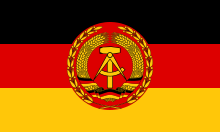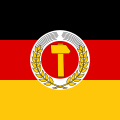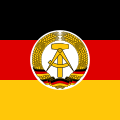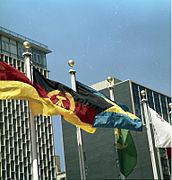Flag of East Germany
| . |
Like the flags of the
It was the official national flag of the German Democratic Republic (East Germany) during its existence from 1959 to 1990. The flag's design and symbolism are derived from the flag of the Weimar Republic and communist symbolism. The flag was outlawed as an unconstitutional and criminal symbol in West Germany and West Berlin, where it was referred to as the Spalterflagge ('secessionist flag') until the late 1960s.
Symbolism and design
With relations deteriorating between the Soviet Union and the United States, the three western Allies met in March 1948 to merge their zones of occupation and allow the formation of what became the Federal Republic of Germany, commonly known as West Germany. Meanwhile, the eastern Soviet zone became the German Democratic Republic, commonly known as East Germany. During the preparation of the new constitution for West Germany, discussions regarding its national symbols took place in August 1948 during a meeting at Herrenchiemsee. Although there were objections to the creation of a national flag before reunification with the east, it was decided to proceed. This decision was primarily motivated by the proposed constitution by the eastern SED in November 1946,[1] where black-red-gold were suggested as the colours for a future German republic.[2]
While there were other suggestions for the new flag for West Germany,
In 1955, the inhabitants of the French-administered Saar Protectorate voted to join West Germany.[5] Since its establishment as a separate French protectorate in 1947, the Saar had a white Nordic cross on a blue and red background as its flag.[6] To demonstrate the commitment of the Saar to be a part of West Germany, a new flag was selected on 9 July 1956: the black-red-gold tricolour defaced with the new coat of arms, also proposed on this day.[7] This flag came into force on 1 January 1957, upon the establishment of the Saarland as a state of West Germany.
While the use of black-red-gold had been suggested in the Soviet zone in 1946, the Second People's Congress in 1948 decided to adopt the old black-white-red
| Colour scheme | Black | Red | Gold | |||
|---|---|---|---|---|---|---|
RAL
|
9005 Jet black |
3020 Traffic red |
1021 Rapeseed yellow | |||
| HKS | 0, 0, 0 | 5.0PB 3.0/12 | 6.0R 4.5/14 | |||
| Pantone | Black | 485 | 7405* | |||
Colour scheme: valid for East German flags 1949–1990
The colours video approximation is listed below:[11]
| Black (flag/arms) |
Red (flag/arms) |
Gold (flag) |
Gold (arms) | |
|---|---|---|---|---|
| RGB | 0/0/0 |
221/0/0 |
255/206/0 |
255/199/9
|
| Hexadecimal | #000000ff |
#dd0000ff |
#ffce00ff |
#ffc709ff
|
| CMYK | 0/0/0/100 |
0/100/100/13 |
0/19/100/0 |
0/22/96/0
|
| HSL | 0/0/0 |
0/255/100 |
34/255/128 |
33/255/132
|
From 1956 to 1964, West and East Germany attended the
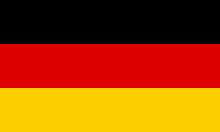
History


 Civil ensign of the GDR from 1959 to 1973
Civil ensign of the GDR from 1959 to 1973On the centenary of the Berlin March days in March 1948, the second
Thus, the
The public presentation of this officially as a "Soviet zone flag" designated by the FRG flag was, however, viewed by the end of the 1960s as a breach of the
Since the situation regarding the recognition of the GDR under international law was complicated as a result of the
With the introduction of the new national flag in 1959 a new
In addition to the East German flag, the red flag of the workers' movement was often hoisted at public buildings, at official events and on national holidays. Only on the Brandenburg Gate did two red flags fly to the left and right of the GDR state flag in the middle until the days after the Berlin Wall fell.
After the political
War and service flags
The flags of the military units of the GDR bore the national coat of arms with a wreath of two olive branches on a red background, on a black, red and gold flag.
The flags of the People's Navy for combat ships and boats carried the coat of arms with an olive branch wreath on a red flag cloth, for auxiliary ships and boats on a blue flag cloth with a narrow black, red and gold band arranged in the middle. The state flag was used in a reduced form as a Gösch.
The ships and boats of the border brigade coast on the Baltic Sea, and the boats of the border troops of the GDR on the Elbe and Oder carried a green bar on the leech, as did the service flag of the border troops.
-
Flag of the National People's Army
-
Flag for combat ships and boats of the Volksmarine
-
Flag for auxiliary ships and boats of the Volksmarine
-
Deutsche Post service flag (1955–1973)
-
Flag for ships and boats of the Coastal Border Brigade
-
Flag of theGrenztruppen
Presidential standards
-
Standard of the president of East Germany (1951–1953)
-
Standard of the president of East Germany (1953–1955)
-
Standard of the president of East Germany (1955–1960)
-
Standard of the president of the State Council (1960–1990)
Historical flags
| Flag | Date | Use | Description |
|---|---|---|---|
 |
1949–1959 | State flag (Staatsflagge) | |
 |
1959–1990 | State flag (Staatsflagge) 1959–1990 Merchant flag (Handelsflagge) 1973–1990 |
Tricolour of black, red, and yellow (same as West German colours), but bears the coat of arms of East Germany, consisting of a compass and a hammer encircled with rye |
 |
1959–1973 | Merchant flag (Handelsflagge) | Used by East German merchant ships prior to its replacement with the East German national flag in 1973 |
  |
1963–1990 | Hanging state flag (Bannerflagge) | Both variants with vertical and horizontal bars were used. |
 |
1975–1990 | Flag of East German Post | |
 |
1960–1990 | Regimental colours (Truppenfahne) of Nationale Volksarmee |
Ceremonial and parade version of the standard military flag |
 |
1989–1990 | Defaced state flag | Used by supporters of German reunification in East Germany after the fall of the Berlin Wall. |
Gallery
-
National flag of the German Democratic Republic flying
-
A GDR flag hanging in the building
-
Series of Red and GDR flags during the 1973 World Festival of Youth and Students
-
Three sets of GDR flags
-
GDR flag hanging in Leipzig, 1965
-
Flag of the GDR with the FRG at the UN headquarters
-
A fan with the GDR flag
See also
References
- ISBN 978-3-7610-5115-3.
- ^ "SED-proposed constitution of the German Democratic Republic". documentArchiv.de (in German). 14 November 1946. Retrieved 24 February 2008.
- ^ a b "Proposals 1944–1949 (Germany)". Flags of the World. Retrieved 30 July 2015.
- ^ Rabbow, Arnold (May–August 1983). "A Flag Against Hitler. The 1944 National Flag Proposal of the German Resistance Movement". Flag Bulletin. 100.
- ^ "The Saar referendum". European Navigator. 23 October 1955. Archived from the original on 11 March 2008. Retrieved 24 February 2008.
- ^ "Constitution of the Saarland". documentArchiv.de. 15 December 1947. Retrieved 24 February 2008. See Article 61. (in German)
- ^ (in German) Government of the Saarland (9 July 1956) Gesetz Nr. 508 über die Flagge des Saarlandes and Gesetz Nr. 509 über das Wappen des Saarlandes
- ^ "Finding the last emblems of the German Democratic Republic in Berlin". 2017-09-06. Retrieved 2021-04-09.
- ^ "Constitution of the German Democratic Republic". documentArchiv.de (in German). 7 October 1949. Retrieved 24 February 2008. See Article 2.
- ^ Government of the German Democratic Republic (1 October 1959). "Gesetz zur Änderung des Gesetzes über das Staatswappen und die Staatsflagge der Deutschen Demokratischen Republik". documentArchiv.de (in German). Retrieved 24 February 2008.
- ^ Based on colors tone values by Inkscape.
- ^ Law amending the Law on the state seal and the state flag of the German Democratic Republic. From 1 October 1959
- ^ Regulation on the introduction of a merchant flag of the German Democratic Republic. From 1 October 1959
- ^ Draft Constitution of East Germany, Working Group "New Constitution of the GDR", the roundtable, Berlin, April 1990
- ^ Article 43, Draft Constitution of East Germany, working group "New Constitution DDR Round Table, Berlin, April 1990




